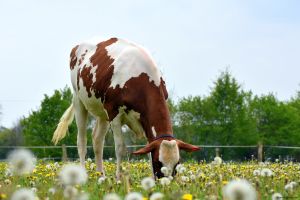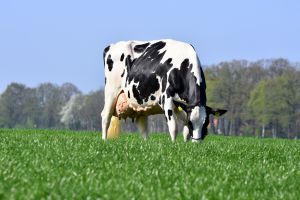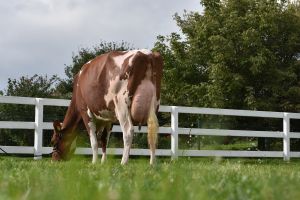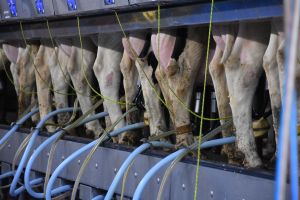Breed description
German Holsteins are the most common dairy breed in Germany. They produce an average of almost 10,000 kg of milk per year with a high protein and fat content. The long-living Holstein cow has a functional conformation with correct feet and legs as well as a high feed intake capacity. A lasting, firmly attached udder that is easy to milk is the basis for many lactations with high milk yields.
Besides high milk yield, profitable Holstein cows also have good fertility with high conception rates and easy calving.
In the context of healthy rearing, the young stock achieve medium daily gains with a high proportion of basic feed or plenty of grazing. The basis for artificial insemination of heifers is not their age, but their physical development. A first calving age between 25 and 28 months has proven to be very positive for the later development of the cow and a high milk yield.
Breeding goal German Holsteins
German Holsteins and Red Holsteins are bred for high lifetime performance. The aim is to breed a high-yielding cow of dairy type, which can be used for many lactations due to stable health, robustness and good fertility. These cows should have an excellent development potential with a high feed intake capacity and optimal feed conversion.
For the milk yield complex, a genetic potential of 10,000 kg milk (305 days yield) with a fat content of 4 % and a protein content of 3.5 % is aimed to achieve lifetime yields of more than 40,000 kg milk.
Full-grown cows should reach a height of 145 to 156 cm and a weight of 650 to 750 kg. Their conformation and movement, including correct and robust feet and legs, must meet the demand for high performance and longevity. A healthy and milkable udder is also required, which allows high daily yields over many lactations in terms of quality and functionality.
German population
Holsteins and Red Holsteins have their origin in the North German coastal areas of the North Sea and the Baltic Sea. The pedigrees of both colour types go back to the 19th century. The German Holstein breed has developed into the most important dairy breed in Germany. There are almost 1.72 million herdbook cows in about 13,350 breeding farms (10/2021), which are characterised by their high willingness to perform. More than 2 million Holsteins and over 220,000 Red Holsteins are included in the milk control. Milk control density, an important parameter for successful breeding programmes, is very high at over 77%.
Herd sizes, herd management and environmental conditions are extremely different in the various regions of Germany and sometimes very demanding for the dairy cows. There are small and medium-sized family farms as well as very large production farms with over a thousand animals. For decades, breeding programmes have been carried out in Germany according to the most modern population genetic and biotechnological findings. They are the cornerstone for the high performance potential and functional conformation of the German Holstein cow.
Breeding programme

For the breeding programme, female cattle are selected at an early stage according to genomic breeding values (Photo: D. Warder)
The breeding programme of German Holsteins is aimed at achieving the breeding goal of a functional dairy cow with high performance potential, health and good conformation. This goal is in the focus of the selection of bull dams and bull sires. Therefore, the total breeding value RZG is the most important selection criterion on the female as well as on the male side. Due to the possibilities of genomic selection, the selection of bulls starts at a very young age on the basis of genomic breeding values. With genomic breeding values, higher certainties are achieved than with pure pedigree-based breeding values.
Another characteristic of the German breeding programme is its diversity. Due to the regional organisational structure, the selection of the next sire generation is not centralised in one place, but is in the hands of the individual breeding organisations. This makes it possible to implement different breeding philosophies in detail. The results are sires that on the one hand fulfil the common goal of a high overall breeding value, but on the other hand are also able to serve markets with different priorities.
The best animals, selected with high intensity from the German breeding population, form the largest part of the bull dams. They are usually selected before the first calving on the basis of genomic breeding values. The highest-tested cattle are often mated with interesting high young bulls within the process of embryo transfer. Contract matings with international top young cattle selected by sire analysts of the breeding organisations based on genomic breeding values complement this potential.
Potentially interesting bull calves are typed as candidates already at the age of a few weeks. From these typed candidates, only the very best ones are selected as new sires. In addition, international sires from other leading countries of Holstein breeding are selected. Sires are considered as bull sires if they are among the best available bulls in the overall breeding values RZG and RZ€. In addition, they must reach a sufficient minimum level in the functional traits.
The potential for a profitable milk production
For decades, breeding programmes in Germany have been carried out according to the most modern knowledge. They form the foundation for the high performance potential and functional conformation of the German Holstein cow. In addition, longevity, fertility and health are characteristics with a very high value.
Both the breeding farms and especially the artificial insemination and embryo transfer organisations are regularly monitored by the state veterinary administration in Germany. Consequently, German cattle herds have an excellent health and hygiene status, which is documented by reliable certificates.
This combination of economically important attributes makes German Holsteins profitable dairy cows that German dairy farmers and their counterparts around the world appreciate equally. Thus, tens of thousands of herdbook cattle are exported to over 40 countries every year. Semen from top German bulls as well as embryos from proven German cow families are in demand worldwide.













